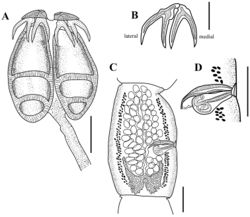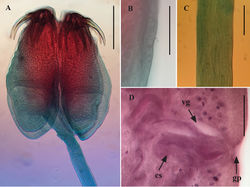Acanthobothrium vidali
Contents
| Notice: | This page is derived from the original publication listed below, whose author(s) should always be credited. Further contributors may edit and improve the content of this page and, consequently, need to be credited as well (see page history). Any assessment of factual correctness requires a careful review of the original article as well as of subsequent contributions.
If you are uncertain whether your planned contribution is correct or not, we suggest that you use the associated discussion page instead of editing the page directly. This page should be cited as follows (rationale):
Citation formats to copy and paste
BibTeX: @article{Zaragoza-Tapia2019ZooKeys852, RIS/ Endnote: TY - JOUR Wikipedia/ Citizendium: <ref name="Zaragoza-Tapia2019ZooKeys852">{{Citation See also the citation download page at the journal. |
Ordo: Onchoproteocephalidea
Familia: Onchobothriidae
Genus: Acanthobothrium
Name
Acanthobothrium vidali Zaragoza-Tapia & Pulido-Flores & Violante-González & Monks, 2019 sp. nov. – Wikispecies link – ZooBank link – Pensoft Profile
Type material
Holotype (CNHE-11134), 7 paratypes (CNHE-11135), 3 paratypes (HWML-139979, 139980, 139981), and 7 paratypes (CHE-P00082).
Other material examined
Acanthobothriumfranus Marques, Centritto & Stewart, 1997 (CNHE–3140, Costa Rica) paratype; A.inbiorium Marques, Centritto & Stewart, 1997 (CNHE–3138, Costa Rica) paratype; A.obuncus Marques, Brooks & Barriga, 1997 (CNHE–3032A, 3167B, Ecuador) holotype; A.soberoni Ghoshroy & Caira, 2001 (CNHE–4042, México).
Type host
Narcineentemedor Jordan & Starks, 1895 (Elasmobranchii: Torpediniformes: Narcinidae).
Type locality
Bahía de Acapulco (Playa Las Hamacas: 16°51'11"N, 99°53'59"W), Guerrero, México.
Site of infection
Spiral intestine.
Quantitative descriptors of parasite populations (Bush et al. 1997[1])
Prevalence = 36.36% (4 of 11 rays were infected); abundance = 1.91 (21 helminths in 11 rays); mean intensity = 5.25 (21 helminths in 4 infected rays).
Etymology
The species is named in honor of Dr Victor Vidal Martínez (Departamento de Recursos del Mar, CINVESTAV-IPN, Merida, Yucatan, Mexico), for his contribution to our knowledge of helminths of fishes from Mexico.
Diagnosis
Acanthobothriumvidali sp. nov. is a Category 6 species. This species is large, with a range of 164–214 craspedote proglottids, with a range of 50–76 testes per proglottid, and the arms of ovary unequal in length (asymmetrical). This new species also can be distinguished from similar congeners by total length, number of proglottids, diameter of accessory sucker, the length of the cirrus sac, number of testes per proglottid, and size of the hooks.
Description
[Based on 5 complete worms and 16 partial specimens] Worms 26.5–70.9 mm (n = 5) long, greatest width at level of mature proglottids, euapolytic; 164–214 (n = 5) proglottids per worm. Scolex 880–1,400 (n = 20) long by 680–1,170 (n = 20) wide, with four bothridia; maximum width of scolex at level of posterior margin of anterior loculus (Figs 3A, 4A). Bothridia free posteriorly, tri-locular, 770–1,230 (n = 20) long by 320–570 (n = 20) wide, with anterior muscular pad (Figs 3A, 4A). Muscular pad 250–325 (n = 18) wide, with apical sucker 75–150 (n = 19) and one pair of bipronged hooks at posterior margin (Figs 3A, 4A). Anterior loculus of bothridia 400–650 (n = 20) long; middle loculus 170–310 (n = 20) long; posterior loculus 150–340 (n = 20) long (Figs 3A, 4A); loculus length ratio (anterior:middle:posterior) 1:0.48:0.50. Velum between medial margins of bothridia in dorsal or ventral pairs not seen (Figs 3A, 4A). Hooks bipronged, hollow, with tubercle on proximal surface of axial prong; internal channels of axial and abaxial prongs continuous, smooth, base and anterior part of each hook embedded in musculature of scolex, tips of prongs free (Figs 3A, B, 4A). Bases (handles) of medial and lateral hooks articulate with one another (Figs 3B, 4A). Lateral hook measurements (n = 15): A 140–170, B 200–285, C 140–305, D 360–465; Medial hook measurements (n = 15): A’ 100–165, B’ 225–300, C’ 200–270, D’ 300–425. Cephalic peduncle 2.38–9.13 mm (n = 15) long by 0.15–0.23 mm (n = 15) wide, microtriches not seen on the scolex or cephalic peduncle (Figs 3A, 4A, B, C). Proglottids craspedote. Immature proglottids 50–230 (n = 17) long by 240–520 (n = 17) wide, mature proglottids 260–700 (n = 10) long by 300–790 (n = 10) wide (Fig. 3C), terminal proglottids 1,120 (n = 1) long by 480 (n = 1) wide. Genital pore marginal, irregularly alternating, 49%–63% (n = 9) of proglottid length from anterior end in mature proglottids; genital atrium present (Figs 3C, D, 4D). Testes arranged in two to three irregular columns on each side of the uterus, in frontal view testes wider than long in mature proglottids, 50–125 (n = 6) long by 40–50 (n = 6) wide (Fig. 3C). In terminal proglottids, anteriormost testes wider than long and posteriormost testes longer than wide. Total number of testes 50–76 (n = 10), aporal 26–40 (n = 10), poral 23–36 (n = 10), preporal 17–26 (n = 10), postporal 5–11 (n = 10). All testes located anterior to ovarian isthmus. Cirrus sac pyriform, 125–175 (n = 6) long by 30–75 (n = 6) wide in mature proglottids (Figs 3C, D, 4D). Cirrus armed. Vagina anterior to cirrus sac (Figs 3C, D, 4D),walls relatively thick, covered with gland cells. Vagina extending laterally from common genital atrium, following anterior margin of cirrus sac, weakly sinuous posteriorly along medial line of proglottid to oötype (Fig. 3C); vaginal sphincter absent. Seminal receptacle not seen. Ovary in mature proglottids H-shaped in frontal view (Fig. 3C); posterior lobes wider than anterior lobes. Ovarian isthmus approximately 2/3 of the distance from anterior end of ovary. Arms of ovary unequal in length, aporal arm always longer than poral arm (Fig. 3C). Aporal arm 150–260 (n = 8) long, reaching to posterior margin of cirrus sac, poral arm 125–225 (n = 8) long in mature proglottids, not reaching posterior margin of cirrus sac. Mehlis’ gland posterior to ovarian isthmus. Vitiellarium follicular, forming lateral bands, extending from near anterior margin of proglottid to near posterior margin of proglottid (Fig. 3C); follicles 15–20 (n = 8) long by 10–15 (n = 8) wide. Uterus thin-walled, saccate, extending from anterior margin of proglottid to near posterior margin of proglottid. Excretory ducts lateral. Gravid proglottids and eggs not seen.
Remarks
There are 14 Category 6 species of Acanthobothrium that have been described worldwide. Of these, seven species have been found in the Pacific Ocean, four of which are amphi-American (Table 2). Acanthobothriumvidali sp. nov. also is a Category 6 species, bringing the total number to 15. Category 6 species have a total length >15 mm (the length of A.vidali sp. nov. is 26.5–70.9 mm), a strobila made up of > 50 proglottids (A.vidali sp. nov. has 164–214 proglottids), number of testes per proglottids ≤ 80 (A.vidali sp. nov. has 50–76 testes per proglottid), and the arms of the ovary are asymmetrical.
As presented in Table 2, the new species can be distinguished from similar Category 6 species of Acanthobothrium that have been described from the Pacific Coast of the Americas (amphi-American species), and from others parts of Pacific Ocean by the measurementes given in Table 2. The total length of the new species (26.5–70.9 mm) is longer than that of A.aetiobatidis (Shipley, 1900) Southwell, 1925. The number of proglottids of the new species (164–214) is greater than that of A.gonzalesmugaburoi Severino & Sarmiento, 1979. The diameter of accessory sucker of the new species (75–150) is larger than that of A.obuncus (33–48) and A.soberoni (40–65). The length of the cirrus sac of the new species (125–175) is shorter than that of A.obuncus (258–322), A.aetiobatidis (200–250), and A.rodmani Fyler, Caira & Jensen, 2009 (190–234). The number of testes per proglottid of the new species (50–76) is greater than that of A.aetiobatidis (23–28), A.arlenae Campbell & Beverage, 2002 (17–26), and A.rodmani (17–26). Finally, the measurements of the hooks of the eight species can be found in Table 2.
The new species is the fourth species of Acanthobothrium reported from N.entemedor, preceded by A.franus and A.inbiorium (Category 5 species), and A.soniae sp. nov. (Category 2 species) described above. All species have been reported from the Pacific Coast of the Americas. Acanthobothriumvidali sp. nov. can be distinguished from these other species by number of proglottids (164–214) is greater than that of A.franus (68–141) and A.soniae sp. nov. (10–13). The total length of the lateral hook of A.vidali sp. nov. (360–465) is longer than that of A.inbiorium (95–120 µm). The length of the axial prong of the lateral hook of A.vidali sp. nov. (200–285) is longer than that of A.inbiorium (65–75 µm) (Table 3).
| Species of Acanthobothrium | Total length (mm) | No. of proglottids | Diameter of accesory sucker (μm) | Length of cirrus sac (μm) | No. of testes per proglottid | Measurements of hook (μm) | |||
|---|---|---|---|---|---|---|---|---|---|
| A | B | C | D | ||||||
| Pacific coast of the Americas | |||||||||
| A.vidali sp. nov. | 26.5–70.9 | 164–214 | 75–150 | 125–175 | 50–76 | 140–170 | 200–285 | 140–305 | 360–465 |
| A.gonzalesmugaburoi Severino & Sarmiento, 1979 | – | 38–63 | – | – | – | 50–87 | 67–123 | 57–120 | 146–219 |
| A.maculatum Riser, 1955 | – | – | – | – | – | 72–78 | 72–78 | 75–78 | 135–141 |
| A.obuncus Marques, Brooks & Barriga, 1997 | – | – | 33–48 | 258–322 | – | 66 | 60–64 | 63–64 | 126–130 |
| A.soberoni Ghoshroy & Caira, 2001 | – | – | 40–65 | – | – | 45–88 | 43–90 | 65–100 | 86–158 |
| Other parts of the Pacific Ocean | |||||||||
| A.aetiobatidis (Shipley, 1900), Southwell, 1925 | 15–20 | – | – | 200–250 | 23–28 | – | 120–130 | 120–130 | 250–280 |
| A.arlenae Campbell & Beveridge, 2002 | – | – | – | – | 17–26 | – | 160–179 | – | 289–344 |
| A.rodmani Fyler, Caira & Jensen, 2009 | – | – | – | 190–234 | 17–26 | – | – | – | 335–357 |
| Species of Acanthobothrium | Total length (mm) | No. of proglottids | Diameter of accesory sucker (μm) | Length of cirrus sac (μm) | No. of testes per proglottid | Measurements of hook (μm) | |||
|---|---|---|---|---|---|---|---|---|---|
| A | B | C | D | ||||||
| Reported from Narcineentemedor | |||||||||
| A.franus Marques, Centritto & Stewart, 1997* | 16.0–40.0 | 68–141 | 60–159 | 102–281 | 24–59 | 118–175 | 245–319 | 223–322 | 354–465 |
| A.inbiorium Marques, Centritto & Stewart, 1997 | 28.0–82.0 | 156–223 | 20–75 | 122–285 | 44–73 | 35–50 | 65–75 | 50–60 | 95–120 |
| A.soniae sp. nov. | 2.9–6.7 | 10–13 | 45–50 | 55–90 | 31– 47 | 43–45 | 88–105 | 83–93 | 125–138 |
| A.vidali sp. nov. | 26.5–70.9 | 164–214 | 75–150 | 125–175 | 50– 76 | 140–170 | 200–285 | 140–305 | 360–465 |
Original Description
- Zaragoza-Tapia, F; Pulido-Flores, G; Violante-González, J; Monks, S; 2019: Two new species of Acanthobothrium Blanchard, 1848 (Onchobothriidae) in Narcineentemedor Jordan & Starks, 1895 (Narcinidae) from Acapulco, Guerrero, Mexico ZooKeys, 852: 1-21. doi
Images
|
Other References
- ↑ Bush A, Lafferty K, Lotz J, Shostak A (1997) Parasitology meets ecology on its own terms: Margolis et al. revisited.Journal of Parasitology83: 575–583. https://doi.org/10.2307/3284227

